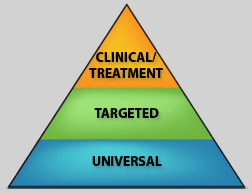As a health care provider treating children, you have an opportunity to make a difference in how children and their families experience illness, injury, and the medical care they receive.
Providers treating children and families already have many of the basic skills required. The information and tools on this site can help you hone and enhance your skills.
Trauma-Informed Pediatric Care means incorporating an understanding of traumatic stress in each clinical encounter with ill or injured children and their families.
When and How You Can Make a Difference: Levels and Phases of Care
Opportunities for trauma-informed care arise at each phase of medical care – from emergent treatment or a new diagnosis, through ongoing treatment of chronic illness or sequelae of injury.

A public health prevention model provides a useful framework for trauma-informed care:
- CLINICAL / TREATMENT interventions are aimed to the smaller number of children and families with more severe or long-lasting distress,
- TARGETED interventions are for those with risk factors or immediate needs, and
- UNIVERSAL interventions are appropriate for ALL pediatric patients and their families.
The D-E-F Protocol for Trauma-Informed Pediatric Care

Health care providers are experts in treating illness, restoring functioning, and saving lives. "A-B-C" orients providers to the crucial first steps to save a life (Airway, Breathing, Circulation). "D-E-F" can help providers remember the key initial steps for children’s emotional recovery from illness or injury.
The D-E-F protocol provides a straightforward and reliable method for identifying, preventing, and addressing traumatic stress responses at the time of need and within the health care provider’s scope of practice.
- Minimize potentially traumatic aspects of medical care and procedures
- Provide child and family with basic support and information
- Address distress (pain, fear, loss)
- Promote emotional support (help parents and family help child)
- Remember family needs (and identify family strengths)
- Screen for acute distress and risk factors to determine which children and families might need more support, and make appropriate referrals
- Provide anticipatory guidance about what to expect and adaptive ways of coping
- Maximize continuity of care so that all providers understand child’s traumatic stress reactions and coping strengths
- Attend to health care providers’ own stress and self-care



